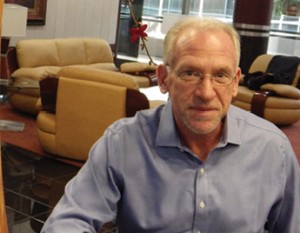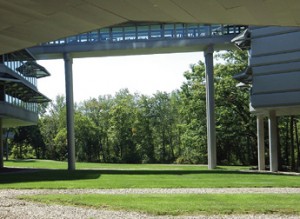Matrix adapts a monolith to a new, nimble world
The Matrix Corporate Center in Danbury was built in 1980 as the 1.2-million-square-foot world headquarters for chemical veteran Union Carbide. Those who worked or visited the company”™s 650-acre campus wended through a half-mile of woods to get to the Kevin Roche-designed building floating on 5,000 cement columns.
Today, the building sits on a parcel whittled to 100 acres and surrounded by suburban developments. Once the embodiment centralized corporate might, the building, with nearly 1 million square feet of covered parking, has been reinvented to remain a viable commercial presence, including a new 22,000-square-foot shared workspace run by Matrix Executive Suites LLC, an arm of Gera Danbury LLC/Matrix Realty Group.
“Adapt or die is a perfect way to put it,” Michael Brown, Matrix”™s director of commercial real estate services, said. “There are no IBMs and no Union Carbides waiting to come into 1 million square feet. There”™s none of that happening anymore.”
Temporary spaces also include use of open-air kitchenettes with marble-topped tables and modern sinks and refrigerators. Remade public meeting sites throughout the building lead to upscale living rooms, complete with showroom furniture and accessories.
Seated in just such a leather-and-marble common space, Brown said, “Every square inch of an office has value and public spaces like this technically do not make us any money. But the space is accountable by being subservient to other things. It creates a sense of community.”
NewOak, when it left its temporary quarters in the Matrix for permanent offices down the hall, used open design to give each employee about 100 square feet, down from the 300 square feet each employee had required with the company”™s former layout scheme in New York City. Companies are free to choose their own builders, but Brown praised Matrix Realty Group”™s in-house construction crew, saying it is chosen for refurbishments 100 percent of the time. One recent request was for acoustic ceiling tiles that mimicked clouds in one room and cushions in another.
A second shared work space of 11,000 square feet is planned at the Matrix, to be followed by another 22,000-square-foot shared space. About 100 businesspersons are using the shared space now, where Matrix”™s Mary O”™Hanlon is the office administrator. A one-time temporary-space user ”” national credit, valuation and risk company NewOak ”” is now a 10,000-square-foot permanent resident, elevating Danbury to the headquarters status of its New York City and Dallas offices.
Brown cited NewOak ”” which asked for the acoustic ceiling layouts ”” as an example of the building”™s adaptable ethos. NewOak arrived on the winds of Superstorm Sandy. The building”™s ready-to-change business plan and Matrix”™s own in-house construction arm came into play.
“They had no power,” Brown said, recalling the New Oak call after Sandy hit. “When the question arose: How quickly could we have them up and running with an office, phones, telecommunications, broadband? I said two to three hours. The power was slow to come on in New York and they brought up more people. We opened our gym; people needed to shower. We became a focus point for their workers and a real community resource.”
Tenant Helen of Troy, which offers women”™s wear and accessories, provided soaps and blow driers to those seeking shelter from Sandy.
Brown, a mechanical engineer by education and also a licensed real estate broker, noted the building is on the same electric grid as Danbury Hospital and that it also has new backup generators, currently being installed.
“I cannot remember a time when we were down,” he said.
Sturdy pillars of American business like carmaker GM, tech manufacturer Honeywell, pharmaceutical company Boehringer Ingelheim and industrial gas producer Praxair have found new spaces in the building under Matrix”™s eight-year ownership. Those tenants might seem logical follow-ups to the presence of Union Carbide. But the current $500,000 being spent in consultancy fees tells of a new, nimble direction.
“The new way of thinking is live, work, play,” Brown said. “The corporate center at the top of the hill, locked down by design in the middle of the woods is gone. We”™ve come to a turnaround point. Today, if you were to build this, you”™d build it at the edge of the parcel.”
To date, Brown said Matrix has spent “at least $30 million” remaking the building”™s HVAC and boiler plants, doing site work and installing generators. Brown said the parcel is home to archaeological sites, which are registered with the state. Every window looks out on forest and the forest is woven with trails that are now open to the surrounding neighborhoods made up of Virginia-based Harbor Group”™s Crown Point at the Reserve Apartments and Pennsylvania-based Toll Brothers”™ Rivington development. It adds up to what Brown termed “a unique animal” that includes some first-floor offices floating 60 feet in the air and, increasingly, also includes workers who live in the neighborhood.
But the building lacks a friendly front door. Cars drive around the spoked structure and, by design, park close to where they are where they are headed. That worked for Union Carbide, but will soon change. The building is seeking to alter its entry, including for a new Corporate Drive off Saw Mill Road. Such an entry would be conducive to a new planned visitor/conference center.
In the world of municipal zoning, said Brown, “The old industrial designation is turning into an electronic version.” One of his roles, he said, is educating cities about trends in remaking office parks. He said Danbury officials ”” including the mayor”™s office, zoning and building departments and the Greater Danbury Chamber of Commerce, have been “great partners.”


